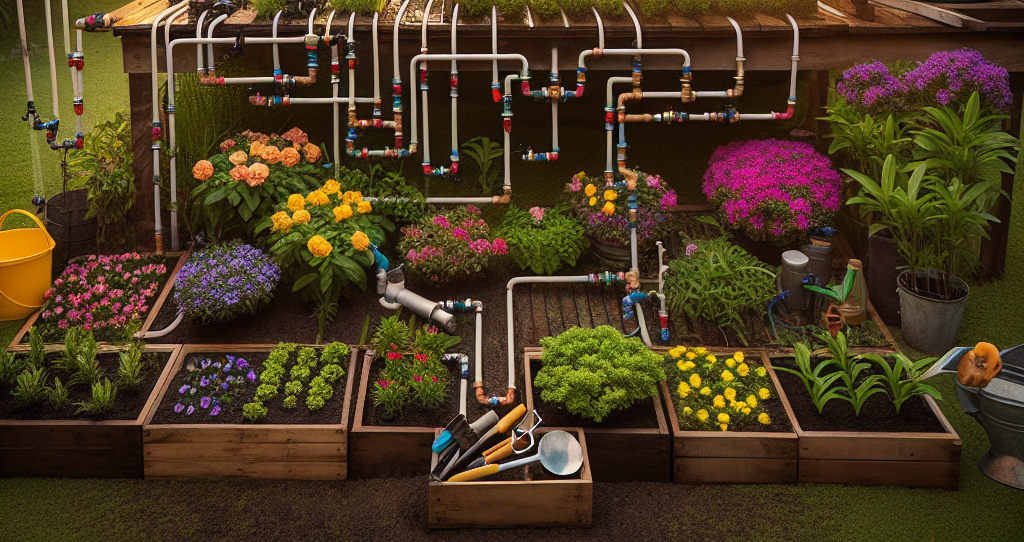Gardening is an enriching endeavor that allows us to connect with nature while beautifying our surroundings. However to ensure your plants thrive a reliable irrigation system is crucial. Without adequate watering even the most meticulously planned garden can suffer. This comprehensive guide will delve into various DIY irrigation techniques that will transform your garden into a flourishing oasis.
By adopting these techniques you will not only maintain lush greenery but also optimize water use and minimize maintenance effort. Let us explore how to create a sustainable and Your Garden Into An Oasis With These DIY Irrigation system tailored to your gardens specific needs.
Why DIY Irrigation is Essential for Your Garden
Irrigation is more than just watering your plants. It is about creating an environment where they can flourish. Inadequate watering can lead to stress disease and even death of plants. Moreover establishing a reliable irrigation system becomes paramount with the increasing effects of climate change unpredictable rainfall and water scarcity.
Key Benefits of a DIY Irrigation System
- Consistent Moisture Levels: A DIY irrigation system guarantees that your plants have a constant water source reducing the chance of drought-related stress.
- Time Efficiency: Automating your irrigation system saves time letting you enjoy your garden instead of working in it.
- Cost-Effective: Setting up a DIY irrigation system is generally much cheaper than hiring a professional. It offers customization options to meet the specific needs of your garden.
- Water Conservation: Efficient systems reduce waste and minimize water bills making your garden eco-friendly.
- Enhanced Plant Health: Proper watering promotes healthy root development and reduces the likelihood of diseases associated with poor watering practices.
These benefits underline the importance of investing time and resources into creating a sustainable irrigation system that suits your gardening style and needs.
Choosing the Right Irrigation System for Your Garden
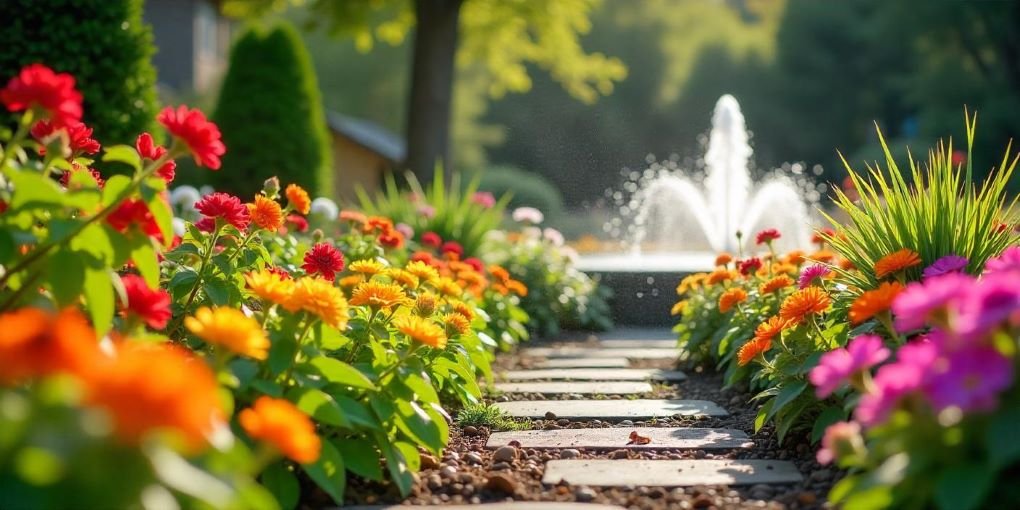
Selecting the best irrigation method involves considering various factors such as the size of your garden types of plants and local climate. Here is a comparison of some popular DIY irrigation systems to help you decide:
| Garden Type | Ideal Irrigation System | Key Advantages |
|---|---|---|
| Minor Urban Gardens | Drip Irrigation | Precise water usage minimal maintenance |
| Medium Gardens | Soaker Hose System | Uniform water distribution eco-friendly |
| Large Landscapes | Sprinkler System | Covers large areas efficiently |
| Sustainability Focus | Rainwater Harvesting or Solar-Powered | Renewable reduces water bills |
DIY Drip Irrigation: Water-Saving Solution for Every Garden
Drip irrigation is a great way to water your plants at their roots. It reduces water waste by minimizing evaporation and runoff ensuring your plants receive hydration.
Materials Needed:
- Polyethylene tubing (1/2 inch mainline and 1/4 inch distribution lines)
- Emitters or drippers (various flow rates)
- Connectors and end caps
- Pressure regulator (especially if connecting to a high-pressure water source)
- Filter to prevent clogging
Steps to Install a Drip Irrigation System:
- Design the Layout: Start by sketching your garden layout and marking the positions of your plants. This diagram will guide you in planning where to place your mainline and emitter lines.
- Install the Mainline: Cut the polyethylene tubing to the desired length. Connect it to a water source ensuring it runs along the rows of your garden.
- Attach Emitters: Use a hole punch to create openings in the mainline where you will attach the 1/4-inch distribution lines. Place an emitter close to each plants root zone to ensure adequate watering.
- Connect and Secure: Use connectors to secure the distribution lines to the emitters and place them in the soil. Make sure the tubing is buried slightly to protect it from sunlight.
- Test the System: Turn on the water supply and check for leaks. Ensure that each emitter delivers water as expected adjusting as needed.
- Maintain the System: Regularly check for clogs in the emitters and clean the filter to keep your system running smoothly.
Advantages of Drip Irrigation:
- Water Conservation: Water conservation uses significantly less water than traditional methods.
- Reduced Disease Risk: Water is delivered directly to the roots reducing foliage wetness and preventing diseases.
- Customizable Flow Rates: Adjust emitters to cater to different plants water requirements ensuring each plant receives optimal hydration.
Investing in a drip irrigation system creates an efficient low-maintenance watering solution that allows your garden to flourish.
DIY Sprinkler System: Ideal for Larger Gardens
For more extensive gardens or lawns a sprinkler system is an effective way to ensure that all areas receive adequate water. Sprinklers can cover extensive spaces distributing water evenly across your garden and miming natural rainfall.
Materials Needed:
- PVC pipes and fittings
- Sprinkler heads (fixed or rotating depending on garden layout)
- Pipe connectors
- Timer (for automation)
- Water source connection
Steps to Set Up a DIY Sprinkler System:
- Measure Your Garden: Determine the size of your garden and the best locations for sprinkler heads to ensure optimal coverage.
- Plan the Layout: Sketch a layout of your system indicating where the primary pipes will run and where each sprinkler head will be positioned.
- Dig Trenches: Dig trenches to place the PVC pipes. This not only keeps them secure but also prevents damage from lawn equipment.
- Install PVC Pipes: Lay the PVC pipes in the trenches connecting them with fittings. Ensure the pipes have no sharp twists or turns so that water can flow smoothly.
- Attach Sprinkler Heads: Install the sprinkler heads at appropriate intervals ensuring they can cover their designated areas without overlap or dry spots.
- Connect to Water Supply: Connect the mainline to your water source and test the system to ensure all parts function correctly.
- Automate with a Timer: Add a timer to your sprinkler system for convenience allowing you to set watering schedules without manual intervention.
Benefits of a Sprinkler System:
- Extensive Coverage: Perfect for larger gardens ensuring all areas receive adequate water.
- Time-Saving: Automating the system allows for less hands-on time.
- Uniform Watering: Reduces the chances of dry patches and ensures even soil moisture.
Sprinkler systems are a fantastic solution for larger gardening projects allowing for effortless maintenance while keeping your plants healthy and vibrant.
Soaker Hose System: An Eco-Friendly Watering Technique
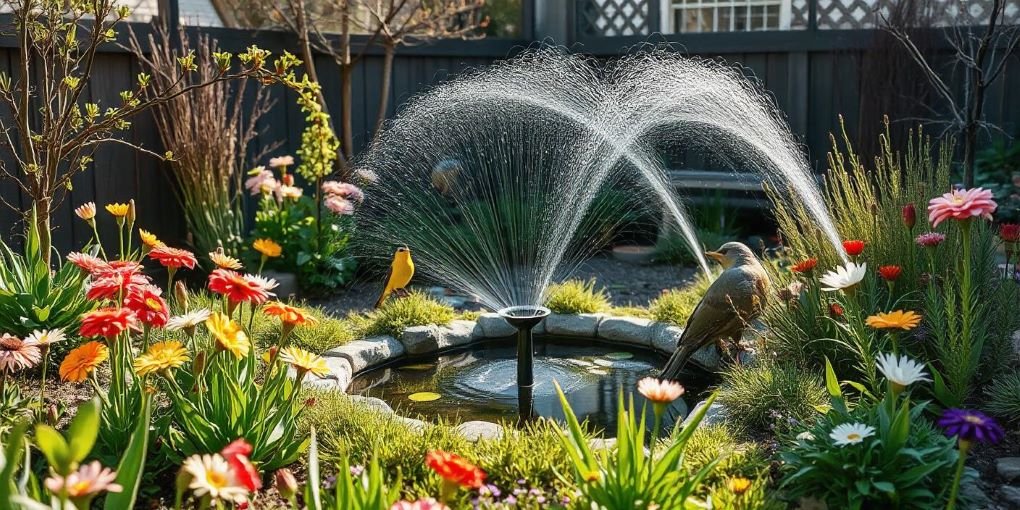
If you are looking for an eco-friendly option a soaker hose system is an excellent choice. This system allows water to seep through the walls of the hose directly into the soil making it particularly suitable for garden beds rows of plants or even under mulch.
Materials Needed:
- Soaker hose (length depending on your garden size)
- Garden hose connectors
- Timer (optional for automation)
Installation Steps:
- Position the Hose: Lay the soaker hose around your plants ensuring it is close to the roots. Depending on your gardens layout you can run the hose in a circular or spiral pattern.
- Connect to Water Source: Attach the soaker hose to a water source ensuring the connection is secure to prevent leaks.
- Check for Kinks: Ensure no kinks or sharp bends in the hose could restrict water flow.
- Set Up a Timer: Optionally use a timer to automate your watering schedule ensuring your garden receives consistent moisture without manual operation.
- Monitor and Adjust: Observe how the plants respond to the watering schedule and adjust the timing or duration as needed.
Advantages of Soaker Hoses:
- Water Efficiency: Reduces evaporation and runoff making it an eco-friendly option.
- Soil Moisture: Maintains consistent moisture levels around plant roots promoting healthy growth.
- Minimal Maintenance: It needs less care and maintenance than other irrigation systems.
A soaker hose system is a simple way to give water straight to your plants ensuring they get what they need.
Rainwater Harvesting: Sustainable and Cost-Effective
Rainwater harvesting is a clever method of capturing rainwater for watering gardens. Not only does this method conserve water but it also reduces your water bill. It lessens the environmental impact of using municipal water.
Materials Needed:
- Rain barrel (preferably 50 gallons or more)
- Gutters and downspouts (to direct rainwater into the barrel)
- Spigot (for easy water access)
- Hose (optional for distribution)
Steps to Implement Rainwater Harvesting:
- Set Up Gutters and Downspouts: Ensure your homes gutters are clean and functional directing rainwater into the rain barrel.
- Install a Rain Barrel: Choose a location near your garden for easy access to the water. Elevating the barrel can help with gravity-based water flow.
- Connect a Hose or Spigot: Attach a hose or spigot at the barrels bottom making it easy to fill watering cans or distribute water to your plants.
- Use a Filter: Consider adding a screen or filter to the top of the barrel to keep out debris and prevent mosquito breeding.
- Monitor Water Levels: Monitor the water levels in the barrel to ensure adequate rainwater collection for your gardens needs.
Benefits of Rainwater Harvesting:
- Cost Savings: Reduces reliance on municipal water supply leading to lower bills.
- Environmental Impact: Conserves water and reduces runoff that can cause erosion and pollution.
- Sustainable: Provides a renewable water source that can be used during dry spells.
A rainwater harvesting system can significantly enhance your gardens irrigation strategy while promoting sustainable practices.
Solar-Powered Irrigation: Green and Energy-Efficient
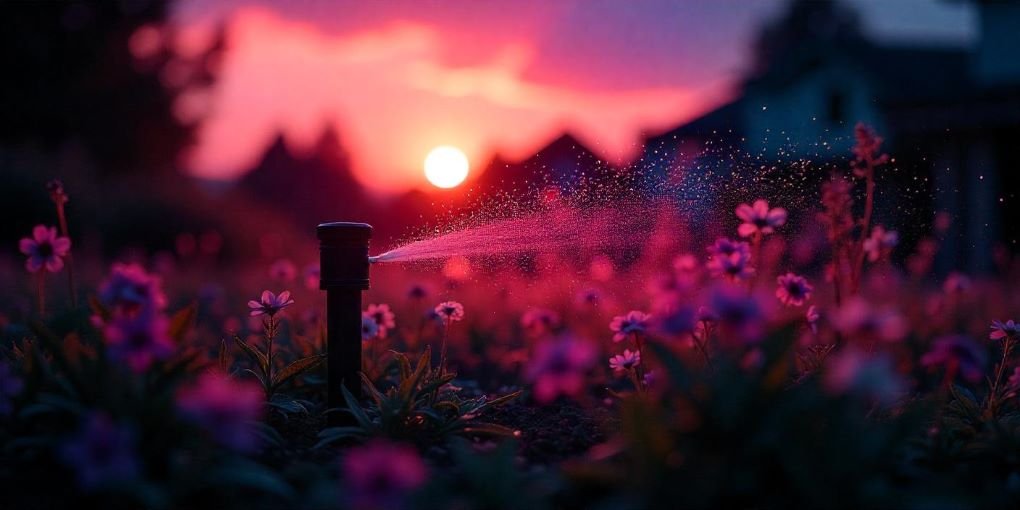
Harnessing solar energy for garden irrigation is a modern and environmentally friendly solution. Solar-powered systems can reduce reliance on conventional electricity Lowering operational costs while reducing your carbon footprint.
Materials Needed:
- Solar panel (appropriate for your water needs)
- Water pump (compatible with your solar panel)
- Battery (optional) for energy storage
- Hoses and fittings
Steps to Create a Solar-Powered Irrigation System:
- Select a Location: Choose a sunny area for your solar panel installation. Make sure it gets plenty of sunlight during the day.
- Install the Solar Panel: Mount the solar panel securely to avoid damage. Position it at an angle to maximize sun exposure.
- Connect the Water Pump: Connect the solar panel to the water pump using appropriate wiring by following these steps. Ensure the pump can handle the desired water flow.
- Set Up Irrigation Lines: Lay out hoses to distribute water throughout your garden connecting them to the pump.
- Test the System: Run the system to ensure everything is functioning correctly. Adjust the pump settings as necessary to achieve the desired water flow.
- Monitor and Maintain: Regularly check the solar panel for dirt or debris that may reduce efficiency. Keep the pump clean and free of obstructions.
Advantages of Solar-Powered Irrigation:
- Energy Efficiency: Reducing dependence on non-renewable energy sources leads to lower carbon emissions.
- Cost-Effective: Decreases electricity bills while providing a sustainable energy source.
- Versatile: Can be adapted for various garden sizes and types.
By investing in a solar-powered irrigation system you not only benefit your garden but also contribute to a more sustainable future.
Other Innovative DIY Irrigation Methods
In addition to the techniques discussed several other innovative DIY irrigation methods can further enhance your gardens watering efficiency:
- Wicking Beds: This method uses capillary action to draw water from a reservoir beneath the soil keeping the bed moist without over-saturating.
- Self-Watering Containers: Ideal for smaller gardens or patios these containers have a built-in reservoir that supplies water as needed reducing daily maintenance.
- Berm or Swale: These landscaping features can capture and redirect rainwater towards your plants ensuring they receive sufficient hydration.
Each method can be customized to suit your gardens needs allowing you to create a unique irrigation system that maximizes water efficiency and plant health.
Maintenance Tips for DIY Irrigation Systems
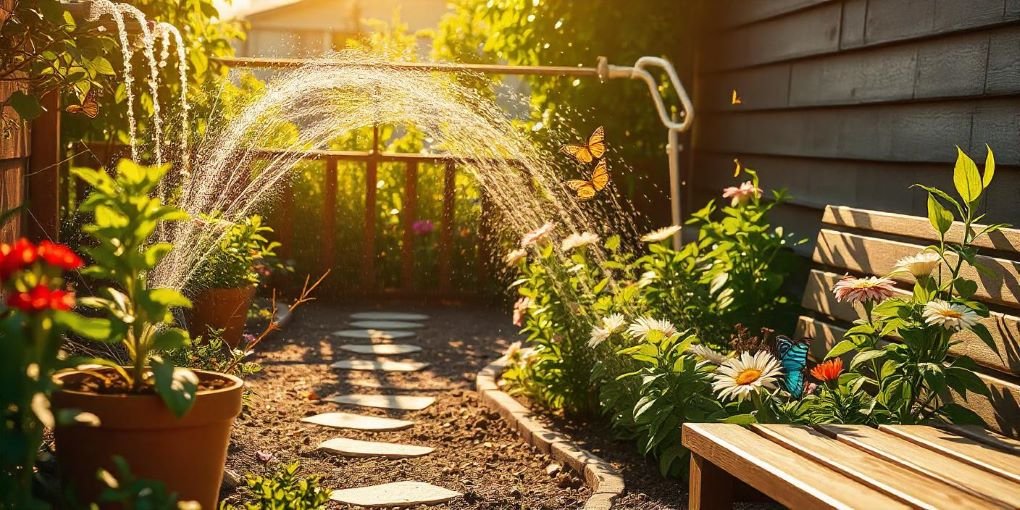
Daily maintenance is essential for ensuring that your equipment functions properly. DIY irrigation system functioning optimally. Here are some essential tips:
- Inspect for Leaks: Regularly check your pipes hoses and connectors for leaks or damage repairing as needed to prevent water loss.
- Clean Filters and Emitters: Keep filters and emitters clean to ensure proper water flow. Clogs can lead to uneven watering and plant stress.
- Monitor Soil Moisture: Use moisture meters or manually check the soil to determine if your system provides adequate plant moisture.
- Adjust Watering Schedules: As seasons change so do your gardens watering needs. Adjust your schedules accordingly to ensure optimal hydration.
- Winterization: In colder climates winterize your system by draining hoses and pipes to prevent freezing and damage.
Integrating these upkeep suggestions into your routine guarantees that your irrigation system functions efficiently Supporting the development of a healthy and thriving garden.
Conclusion
Transforming your garden into an oasis with effective DIY irrigation techniques enhances plant health and promotes sustainability and efficiency. Whether you choose drip irrigation soaker hoses sprinkler systems or rainwater harvesting each method offers unique benefits tailored to your gardening needs.
By implementing these techniques you can create a thriving garden that minimizes water waste while maximizing beauty and productivity. Begin your gardening journey today and see your garden thrive like never before.
FAQs About Your Garden Into An Oasis With These DIY Irrigation
What should I do if my irrigation system is not working correctly?
If your irrigation system is malfunctioning correctly check for leaks clogs or broken components. Ensure all connections are secure and that any filters are clean. If problems persist consult the installation manual or seek online resources to troubleshoot specific issues.
What is a DIY irrigation system?
A DIY irrigation system is a self-installed watering solution designed to supply water to your garden or plants efficiently. This can include various methods like drip irrigation sprinkler systems soaker hoses and rainwater harvesting allowing you to customize your watering approach based on your gardens specific needs.
Why should I consider a DIY irrigation system?
DIY irrigation systems offer numerous benefits including cost savings water conservation and time efficiency. You can customize your watering techniques to suit the specific requirements of your plants encouraging better growth and reducing water waste.
How do I choose the proper irrigation method for my garden?
Choosing the right way to water your garden depends on several essential things. It would help if you thought about how big your garden is what kinds of plants you are growing and the weather where you live.
Can I set up a drip irrigation system on my own?
Yes installing a drip irrigation system is a straightforward DIY project. You can create a customized watering solution for your plants with tools and materials like polyethylene tubing emitters and connectors. Many resources and tutorials are available to guide you through the process.
How do I maintain my irrigation system?
Ongoing upkeep is vital for ensuring your irrigation system operates efficiently. Inspect hoses pipes and connectors for leaks clean filters and emitters to prevent clogs and adjust your watering schedule based on the changing needs of your plants and seasons.
Is rainwater harvesting legal in my area?
Rainwater harvesting laws vary by region. In many areas it is legal and encouraged as a sustainable practice. However check with local regulations to ensure compliance and understand specific requirements for collecting and using rainwater.
What are the benefits of using a solar-powered irrigation system?
Solar-powered irrigation systems harness renewable energy to operate reducing your reliance on traditional electricity. This helps reduce costs and makes your garden friendlier to the environment promoting a healthier planet for everyone.
How much water does a soaker hose use compared to traditional watering methods?
Soaker hoses are highly efficient using significantly less water than traditional overhead watering methods. They deliver moisture directly to the soil reducing evaporation and runoff which helps conserve water while maintaining healthy soil moisture levels.
Can I use a combination of different irrigation methods?
Absolutely Many gardeners combine various irrigation techniques to meet their gardens diverse needs. For example you might use drip irrigation for vegetable beds while employing a rainwater harvesting system for flower gardens.
